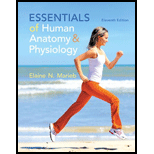
More than one choice may apply.
Pulmonary veins deliver freshly oxygenated blood from the lungs to the
right ventricle.
left ventricle.
right atrium.
left atrium.
Introduction:
Human heart is divided into four chambers, two atria on the left and two ventricles on the right. The upper chambers, atria, receive blood that returns back to the heart. The lower chambers, ventricles, receive blood from the atria, which pump blood out in the arteries.
Answer to Problem 1MC
Correct answer:
The pulmonary veins carry freshly oxygenated blood from the lungs to the left atrium before leaving the heart into the aorta, which in turn helps in the circulation of the blood throughout the body.
Explanation of Solution
Explanation for the correct answer:
Option (d) is given as left atrium. The deoxygenated blood from the right ventricle move to the pulmonary artery and releases carbon dioxide in the lungs. This fresh oxygen-rich blood is returned back to the left atrium of the heart through the pulmonary veins, which later flows into the left ventricle. Hence, option (d) is correct.
Explanation for incorrect answers:
Option (a) is given as right ventricle. The deoxygenated blood rich in carbon dioxide flows into right atrium by systemic circulation and is pumped into the right ventricle. This blood is later pumped out from right ventricle by pulmonary artery, which delivers it into the lungs. The pulmonary arteries carry deoxygenated blood from the heart to the lungs. So, it is an incorrect option.
Option (b) is given as left ventricle. The left ventricle consists of oxygenated blood received from the left atrium. The aorta supplies this blood to the entire body. So, it is an incorrect option.
Option (c) is given as right atrium. The right atrium receives deoxygenated blood that returns from all the organs except the lungs. So, it is an incorrect option.
Hence, options (a), (b), and (c) are incorrect.
Thus, it is evident from the above explanation that pulmonary veins carry freshly oxygenated blood from the lungs to the left atrium.
Want to see more full solutions like this?
Chapter 11 Solutions
Essentials of Human Anatomy & Physiology Plus MasteringA&P with eText -- Access Card Package (11th Edition)
- Can I please get this answered with the colors and how the R group is suppose to be set up. Thanksarrow_forwardfa How many different gametes, f₂ phenotypes and f₂ genotypes can potentially be produced from individuals of the following genotypes? 1) AaBb i) AaBB 11) AABSC- AA Bb Cc Dd EE Cal bsm nortubaarrow_forwardC MasteringHealth MasteringNu × session.healthandnutrition-mastering.pearson.com/myct/itemView?assignment ProblemID=17396416&attemptNo=1&offset=prevarrow_forward10. Your instructor will give you 2 amino acids during the activity session (video 2-7. A. First color all the polar and non-polar covalent bonds in the R groups of your 2 amino acids using the same colors as in #7. Do not color the bonds in the backbone of each amino acid. B. Next, color where all the hydrogen bonds, hydrophobic interactions and ionic bonds could occur in the R group of each amino acid. Use the same colors as in #7. Do not color the bonds in the backbone of each amino acid. C. Position the two amino acids on the page below in an orientation where the two R groups could bond together. Once you are satisfied, staple or tape the amino acids in place and label the bond that you formed between the two R groups. - Polar covalent Bond - Red - Non polar Covalent boND- yellow - Ionic BonD - PINK Hydrogen Bonn - Purple Hydrophobic interaction-green O=C-N H I. H HO H =O CH2 C-C-N HICK H HO H CH2 OH H₂N C = Oarrow_forwardFind the dental formula and enter it in the following format: I3/3 C1/1 P4/4 M2/3 = 42 (this is not the correct number, just the correct format) Please be aware: the upper jaw is intact (all teeth are present). The bottom jaw/mandible is not intact. The front teeth should include 6 total rectangular teeth (3 on each side) and 2 total large triangular teeth (1 on each side).arrow_forward12. Calculate the area of a circle which has a radius of 1200 μm. Give your answer in mm² in scientific notation with the correct number of significant figures.arrow_forwardDescribe the image quality of the B.megaterium at 1000X before adding oil? What does adding oil do to the quality of the image?arrow_forwardWhich of the follwowing cells from this lab do you expect to have a nucleus and why or why not? Ceratium, Bacillus megaterium and Cheek epithelial cells?arrow_forward14. If you determine there to be debris on your ocular lens, explain what is the best way to clean it off without damaging the lens?arrow_forward11. Write a simple formula for converting mm to μm when the number of mm's is known. Use the variable X to represent the number of mm's in your formula.arrow_forward13. When a smear containing cells is dried, the cells shrink due to the loss of water. What technique could you use to visualize and measure living cells without heat-fixing them? Hint: you did this technique in part I.arrow_forward10. Write a simple formula for converting μm to mm when the number of μm's are known. Use the variable X to represent the number of um's in your formula.arrow_forwardarrow_back_iosSEE MORE QUESTIONSarrow_forward_ios
 Human Physiology: From Cells to Systems (MindTap ...BiologyISBN:9781285866932Author:Lauralee SherwoodPublisher:Cengage LearningBasic Clinical Lab Competencies for Respiratory C...NursingISBN:9781285244662Author:WhitePublisher:Cengage
Human Physiology: From Cells to Systems (MindTap ...BiologyISBN:9781285866932Author:Lauralee SherwoodPublisher:Cengage LearningBasic Clinical Lab Competencies for Respiratory C...NursingISBN:9781285244662Author:WhitePublisher:Cengage Medical Terminology for Health Professions, Spira...Health & NutritionISBN:9781305634350Author:Ann Ehrlich, Carol L. Schroeder, Laura Ehrlich, Katrina A. SchroederPublisher:Cengage Learning
Medical Terminology for Health Professions, Spira...Health & NutritionISBN:9781305634350Author:Ann Ehrlich, Carol L. Schroeder, Laura Ehrlich, Katrina A. SchroederPublisher:Cengage Learning Biology (MindTap Course List)BiologyISBN:9781337392938Author:Eldra Solomon, Charles Martin, Diana W. Martin, Linda R. BergPublisher:Cengage Learning
Biology (MindTap Course List)BiologyISBN:9781337392938Author:Eldra Solomon, Charles Martin, Diana W. Martin, Linda R. BergPublisher:Cengage Learning





